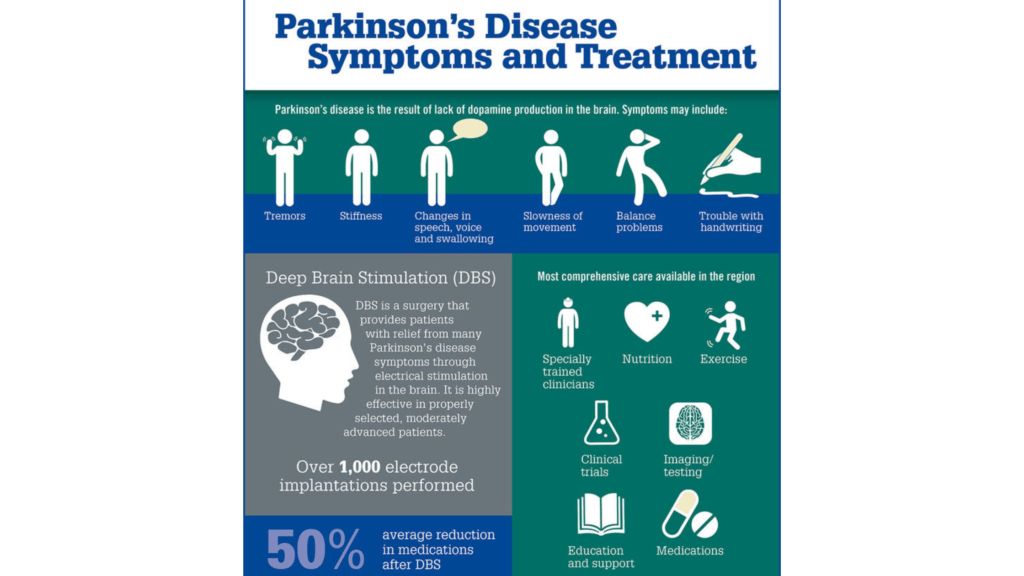Introduction
Parkinson’s disease, a neurodegenerative disorder that profoundly impacts motor function, affects millions of people globally. Despite extensive research, early detection remains a significant challenge, often delaying the initiation of treatment until after substantial neuronal damage has occurred. Recently, a groundbreaking study published in Nature Communications unveiled a major development: new biomarkers identified through plasma proteomics can predict Parkinson’s disease up to seven years before the onset of symptoms. This discovery holds immense potential to transform diagnostic practices and pave the way for early intervention, potentially improving the prognosis for countless patients.
Understanding Parkinson’s Disease
Parkinson’s disease is characterized by the progressive degeneration of dopamine-producing neurons in the brain, particularly in the substantia nigra region. The resulting dopamine deficiency leads to the hallmark symptoms of Parkinson’s: tremors, muscle rigidity, bradykinesia (slowness of movement), and postural instability. Additionally, non-motor symptoms such as cognitive decline, mood disorders, and sleep disturbances often accompany the disease, further complicating its management.
Currently, the diagnosis of Parkinson’s disease relies heavily on clinical observation and the presence of motor symptoms. This symptomatic approach often means that by the time a diagnosis is made, significant neuronal loss has already occurred, limiting the effectiveness of available treatments. Therefore, there is an urgent need for biomarkers that can identify the disease at a pre-symptomatic stage, allowing for earlier and more effective therapeutic interventions.
The Promise of Biomarkers
Biomarkers are measurable indicators of a biological condition or disease. They can be detected in various bodily fluids, such as blood, urine, and cerebrospinal fluid, offering a non-invasive means to monitor health and disease progression. In the context of Parkinson’s disease, biomarkers hold the promise of shifting the diagnostic paradigm from one based on clinical symptoms to one that can detect the disease before symptoms manifest.
The identification of reliable biomarkers for Parkinson’s disease would revolutionize early diagnosis and management. It would enable healthcare providers to monitor at-risk individuals more closely, initiate early interventions, and potentially slow the progression of the disease. Furthermore, biomarkers could facilitate the development of new therapies by providing a means to measure disease progression and treatment efficacy in clinical trials.
Breakthrough in Plasma Proteomics
Plasma proteomics, the large-scale study of proteins in blood plasma, has emerged as a powerful tool in biomarker discovery. Proteins play crucial roles in virtually all biological processes, and changes in their expression or modification can reflect underlying pathological conditions. By analyzing the protein composition of plasma, researchers can identify specific proteins or patterns of proteins that are associated with a particular disease.
In the recent study published in Nature Communications, researchers employed advanced proteomic techniques to analyze blood plasma samples from individuals who later developed Parkinson’s disease. By comparing these samples with those from healthy controls, they were able to identify distinct protein patterns associated with the disease. This approach not only highlighted the potential of plasma proteomics in biomarker discovery but also demonstrated its applicability to Parkinson’s disease.
The Study: Methodology and Findings
The study in question utilized a cohort of individuals who were initially free of Parkinson’s disease but later developed the condition. Blood plasma samples were collected from these individuals up to seven years before the onset of symptoms. Using advanced mass spectrometry techniques, the researchers performed a comprehensive analysis of the plasma proteome, identifying over 1,000 proteins in each sample.
Through rigorous statistical analysis, the researchers identified a subset of proteins that were significantly different between individuals who developed Parkinson’s disease and those who did not. These proteins, termed biomarkers, were able to predict the onset of Parkinson’s disease with remarkable accuracy, even years before the first clinical symptoms appeared. The findings of this study represent a significant step forward in the early detection of Parkinson’s disease.

The Identified Biomarkers
Among the biomarkers identified in the study were proteins involved in various biological processes, including inflammation, oxidative stress, and neuronal health. Inflammation and oxidative stress are known to play critical roles in the pathogenesis of Parkinson’s disease, and the identified biomarkers reflect these underlying mechanisms. For instance, elevated levels of certain inflammatory proteins were found in individuals who later developed Parkinson’s, suggesting that inflammation may precede the onset of motor symptoms.
Additionally, proteins related to neuronal health and function were also identified as biomarkers. These proteins are involved in processes such as synaptic transmission, neuroprotection, and cell survival, all of which are crucial for maintaining healthy brain function. The presence of these biomarkers in plasma long before symptom onset indicates that neurodegenerative processes may begin well before clinical diagnosis, highlighting the importance of early detection.
Implications for Early Detection
The discovery of these biomarkers has profound implications for the early detection of Parkinson’s disease. By identifying individuals at risk for developing the disease years before symptoms appear, healthcare providers can implement proactive monitoring and early interventions. This could involve lifestyle modifications, neuroprotective therapies, and closer surveillance for emerging symptoms, all of which could significantly improve patient outcomes.
Early detection also has the potential to change the landscape of Parkinson’s disease treatment. Currently, most treatments are aimed at managing symptoms rather than halting or reversing the underlying neurodegenerative processes. With the ability to identify the disease at a pre-symptomatic stage, researchers can explore new therapeutic strategies aimed at preventing neuronal loss and slowing disease progression. This paradigm shift could lead to more effective treatments and ultimately, better quality of life for patients.
Future Prospects and Research Directions
The identification of biomarkers that can predict Parkinson’s disease is a monumental achievement, but it is only the beginning. Ongoing research is needed to validate these findings across larger and more diverse populations. Additionally, further studies are required to understand the biological mechanisms underlying these biomarkers and their role in the pathogenesis of Parkinson’s disease.
Future research will also focus on refining the sensitivity and specificity of biomarker-based tests. This involves developing standardized protocols for biomarker detection and ensuring reproducibility across different laboratories and clinical settings. The integration of biomarker research with other diagnostic tools, such as imaging and genetic analysis, could lead to a comprehensive early detection system for Parkinson’s disease.
Moreover, the potential applications of plasma proteomics extend beyond Parkinson’s disease. This approach could be used to identify biomarkers for other neurodegenerative disorders, such as Alzheimer’s disease and amyotrophic lateral sclerosis (ALS), as well as a range of other diseases. The continued advancement of proteomic technologies and bioinformatics tools will undoubtedly drive further discoveries in this field.
Challenges and Ethical Considerations
While the discovery of predictive biomarkers for Parkinson’s disease is promising, several challenges must be addressed before these biomarkers can be implemented in clinical practice. One of the main challenges is the technical complexity of proteomic analyses. Standardizing these techniques and ensuring their reproducibility is critical for translating research findings into reliable diagnostic tests.
Another significant challenge is the ethical implications of early diagnosis. Knowing that one is at risk for developing Parkinson’s disease years before symptoms appear can have profound psychological and social impacts. It raises questions about the appropriate timing and manner of communicating this information to patients. Furthermore, there are potential issues related to employment, insurance, and discrimination based on pre-symptomatic disease status. These ethical considerations necessitate careful navigation as the technology advances.
Conclusion
The discovery of new biomarkers that can predict Parkinson’s disease up to seven years before symptom onset marks a significant milestone in medical research. This breakthrough, made possible through the application of plasma proteomics, has the potential to transform the approach to diagnosing and managing Parkinson’s disease. By enabling early detection, these biomarkers offer a window for timely interventions that could slow disease progression and improve patient outcomes.
As research continues to validate and refine these findings, the integration of biomarker-based tests into clinical practice could herald a new era of proactive healthcare. This advancement not only holds promise for Parkinson’s disease but also sets the stage for similar breakthroughs in the early detection of other neurodegenerative disorders. While challenges remain, the hopeful future of Parkinson’s diagnostics underscores the importance of continued investment in biomarker research and the development of innovative diagnostic tools.
For more content follow Humstory













